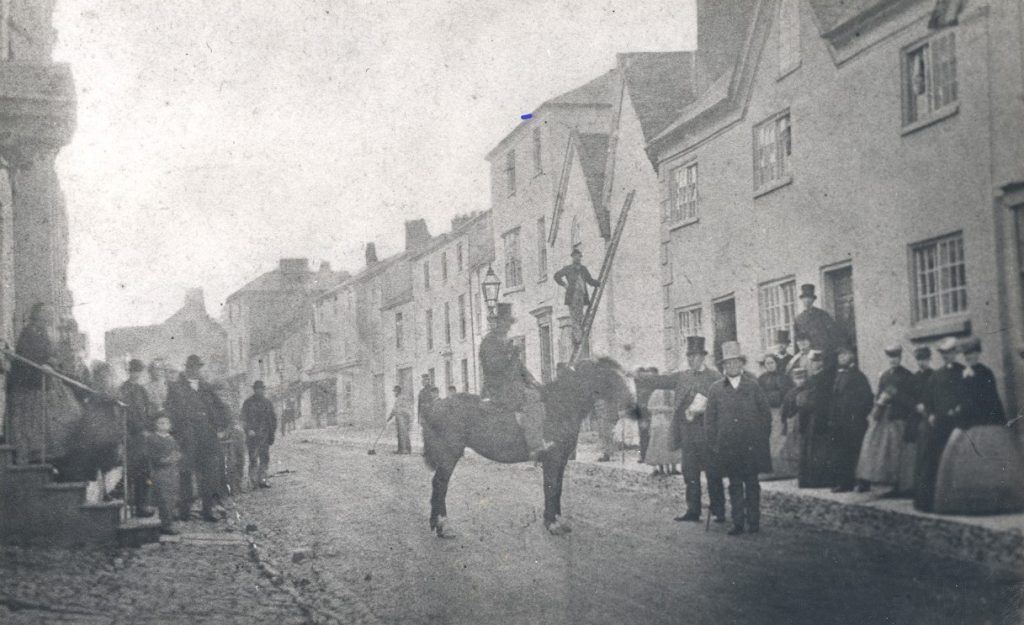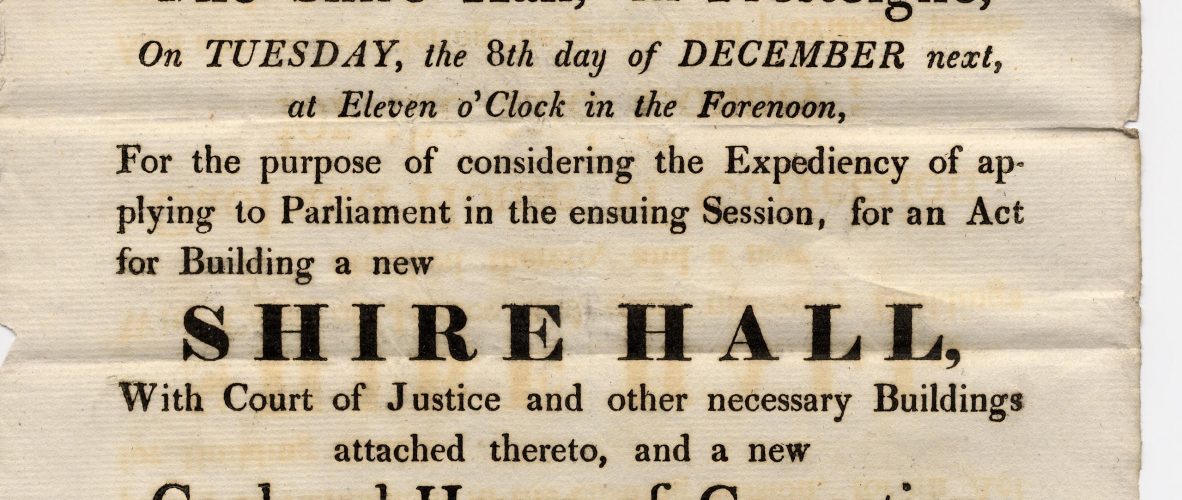The name given to the tight trousers worn by some Regency gentlemen, such as the notorious Beau Brummell and his ‘dandy’ followers, as they showed off their leg muscles.
It all started with a murder…
The murder in Rhayader of one judge in the 1530s was to change the life of the tiny border town of Presteigne forever. Rhayader, chosen as the venue for the Court of King’s Great Sessions, was obviously not a safe enough place for eminent men to stay and in 1542 Presteigne was chosen as an alternative. Its life as the legal seat of Radnorshire was set for more than 400 years and with it the development of Presteigne into Radnorshire’s county town.
By the early 1800s Presteigne was thriving in its legal and administrative role for the county. Not only did it host the Great Sessions (called Assizes after 1830) but also the Quarter sessions, where the Magistrates met to try minor offences and carry out their administrative duties (rather like a County Council does today).
There was a Shire Hall for the trials and hearings, a lodging house for the judges and a gaol. However, the old Shire Hall was on the brink of collapse – in 1828 a local contractor was even paid to prop up the Shire Hall for a parliamentary election! – causing a barrage of complaints from the magistrates. The judges had to be housed at the other end of the town from the court and the gaol was in such disrepair that it was hard for them to keep up with the number that escaped! Something had to be done. The gaol was demolished and a new one built on the edge of town – at least the villains were secure, but what about the judges?
The grand Shire Hall is built
By 1825 the magistrates knew that matters had to be improved. They advertised in the local press for tenders to build a new Shire Hall, Court of Justice and Judge’s Lodging on the site of the old gaol and in 1826 Edward Haycock, an eminent architect from Shrewsbury , was chosen to carry out the work. Beset by financial worries, the magistrates originally ordered that only the shell of the judge’s apartments be built, then a further expense was caused by springs breaking through the ground of the apartments causing a new drainage system to be installed. It was not until 1829 that the lodging rooms themselves were furnished and the building declared finished. This is the earliest known photograph, taken outside the building. We do not know the occassion.

Horses and pants get stolen
On the 24th August the new building housed its first Great Sessions, when a horse thief was sentenced to death (commuted to transportation for life) and a man who had stolen clothing from his employer was likewise sentenced to 14 years transportation. Many of the court cases were written up in the Hereford Times and Hereford Journal, including that of two Rhayader labourers who were arguing over the ownership of a pair of underpants which were apparently identified ‘due to their distinguishing marks’! The Radnorshire juries themselves won a reputation for a reluctance to convict, not surprising when they probably knew the people up before them. It is alleged that one judge, being driven to Knighton to catch his train, spotted a hare being hotly pursued by two greyhounds – ‘nothing but a Radnorshire jury can save that hare’ he cried. Whether or not the story is true, it does reflect the attitude towards the juries of the time! In 1834 a Quarter Sessions Jury was fined for tossing a coin to decided their verdict – the difficult decision being made impossible by one of them being the prisoner’s brother in law.
The building gets used for all sorts
As the years progressed, a number of additional uses were found for this grand and commodious building: In 1834 it was decided that the judge’s apartments were to be rented out when the judge was not in residence – what a waste, they thought for such good rooms to be unused for all but a few weeks of the year! The 1860s saw temperance lectures, brass band concerts, use as the Officers’ Mess of the Radnor Militia in 1865 and in 1874 it hosted a fancy dress ball to celebrate the opening of the Presteigne railway. The 20th century has seen this multitude of uses continue, with the grand rooms being used for many social functions, meetings, elections and even housing the local museum and library.
Decay beckons
By the end of the 19th Century, however, increasing popularity of Llandrindod Wells meant that the newly formed County Council (1888 Local Government Act) chose the thriving spa resort as its future meeting place, sealing the fate of Presteigne’s county town status. Llandrindod did not, however, take the legal duties from Presteigne – it was not until October 1970 when Mr Justice Mars-Jones sat at the Autumn Assizes that the building said goodbye to the judges, with the magistrates continuing to deal with the lesser criminal matters for another 20 years.
As the use of the Shire Hall dwindled, its condition of repair worsened. By the early 1990s drastic action was needed if the building was to be saved from irreversible decay and, even worse, demolition. Several suggestions were made as to what could be done with the building, including part of it being used as a legal or social history display. Historical Consultant, Dr Charles Kightly, was invited to inspect the building and discuss this possibility. The interior was not too bad, despite rampant damp (and redecoration in rather garish 50s designs); some of the original furniture, though rather battered, was still in place and then there were the attics…
